How We Work
Do the photographers you work with gain permission to access and document in the locations and facilities they visit?
Whenever we can access a facility with permission, we do, and as an agency, we won’t ever ask a photographer to break the law. Photojournalists may make the decision to enter property without permission to document industries that cause immense suffering and which are shrouded in secrecy. Civil disobedience is an important part of every social movement and thinking strategically about those choices is important. Investigations can be dangerous and need experienced teams to undertake them. The We Animals Photography Masterclass covers this topic in more detail.
Do you ever rescue the animals you photograph?
We regularly work with groups performing rescue operations and documenting that work is part of our mission to advocate for animals through photojournalism. Our team would of course love to rescue all those who are suffering in these photographs, but sadly we can’t. Our mandate is to show how animals live in the human world, often hidden in plain sight, and to encourage people to truly see the way that animals are treated through our visuals. Our photojournalists document dozens, hundreds, sometimes thousands of suffering animals while they work and it isn’t possible for one organization, let alone one photojournalist, to rescue these animals in need. Leaving these animals behind is a painful decision.
That’s why it’s so vital for people like you to make use of our images to help increase visibility. As photojournalists and filmmakers at We Animals, we are committed to the long-term impact of documentation that reveals the suffering of hidden animals so that, hopefully one day, rescuing is no longer necessary.
How do you choose which animal issues to cover?
We approach our work through the lens of the effective animal advocacy movement. We focus our coverage on the areas where we are most likely to have the largest impact in terms of reducing suffering for the greatest number of animals. Our goal is to equip organizations, journalists, policy-makers and media outlets of all sizes with the images necessary to advance their work, and thus the work of the movement as a whole.
I work with an organization and am interested in collaborating with We Animals. How can I start that conversation?
You can visit our For Organizations page for more information and to get in touch with us.
What kind of camera equipment do you use?
Our photographers and videographers use different types of equipment, depending on the shoot. We Animals Founder and Photographer Jo-Anne McArthur currently shoots with the Nikon D4S as well as the D850. Her staple lenses are a 17mm-35mm f2.8, a 50mm f1.4, a 135mm f2, and a 120mm-400 f4.5/5.6. We Animals filmmaker Kelly Guerin opts for a Panasonic GH4 and a Canon C100 Mark II. The GH4 is Kelly’s preferred camera for most investigations because its smaller size allows her to move through environments more openly, shooting with one body while continuously recording audio on the other.
The topic of field equipment is covered more fully in our We Animals Photography Masterclass.
Do you use hidden cameras?
No. We Animals was borne out of the need for high-quality, journalistic-style animal photography and filmmaking. Hidden camera investigations are hugely important and we work alongside many groups undertaking this kind of work. However, they are not something we currently use.
How do you deal with the stress of seeing animals suffering?
Witnessing animal abuse first hand is a traumatic experience that can have serious impacts on us all. Having a good self-care toolkit is critical for activists; burnout is real and results in talented advocates leaving the animal protection movement for good. Our team members all have different approaches to self-care – everyone is different, and finding techniques and practices that work for you is crucial so that you can stay healthy and keep fighting for animals. We address this topic in greater detail in Episode 5 of our We Animals Photography Masterclass, “Coping With Trauma.”
How does We Animals measure its impact?
The impact of an image is notoriously difficult to measure. Because of this, we rely on reports from organizations and individuals who have used our work, and on identifying the reach of images that have been used to illustrate news stories. You can find a selection of outcomes that We Animals’ work has helped make possible on our Impact page and For Media page.
In addition to the larger concrete successes we’re able to account for, we routinely hear from our audiences – you! – about how our work has influenced your lives in myriad ways. We’d love to hear from you on this front. You can reach us at info@weanimals.org.
Get Involved
How can I get involved?
There are a number of ways you can join us in advocating for animals through photojournalism.
Use our visuals:
Whether you’re covering animal stories, organizing for animals, attempting to change policy, writing papers or conducting research, using our visuals is one of the simplest ways to help us and help animals.
Share:
Follow us on social media and help amplify the impact of our images worldwide. We’re active on Facebook, Instagram, Twitter, LinkedIn and YouTube. You can find us @WeAnimals (and via the social media links on this site).
Volunteer:
If you have specific skills for volunteering, please visit our Join Our Team page to view open opportunities.
Take the We Animals Photography Masterclass:
The We Animals Masterclass series was developed to foster the next generation of animal photojournalists. This online and self-paced video series will teach you the basic foundations of animal photojournalism by following We Animals Founder Jo-Anne McArthur as she covers the lessons she has learned from almost two decades in the field. We also have an exclusive Masterclass Facebook Group. It’s a great way to connect with some of our other participants. Once you’re registered for the Masterclass, you’ll receive an email with joining details. For more information and to purchase, click here.
Submit your portfolio:
Become a We Animals photojournalist. Learn more about becoming a We Animals contributor here.
Organize a fundraiser:
Setting up a peer-to-peer fundraiser is a fun and creative way to engage your friends and family on behalf of animals. Not only will you be sharing your support of our mission, establishing a social fundraiser for We Animals can be a special way to mark a life milestone, celebrate a personal or physical accomplishment, or honour the memory of a loved one. Learn more here.
Support our work:
We Animals is a Canadian non-profit agency that makes the majority of our content available for free. We Animals exists thanks to generous donations, monthly supporters and grants. Consider becoming a We Animals Ally to sustain our work year-round. See here for more information on how to become a We Animals supporter.
Where can I purchase We Animals books?
HIDDEN: Animals in the Anthropocene, We Animals and Captive are all available on Amazon and via Lantern Books. Write to us at books@weanimals.org to request a signed copy.
How can I stay up-to-date on We Animals projects and initiatives?
Subscribe to our We Animals newsletter here. Each month you’ll be the first to know about new photos and videos; invitations to events; our field work; campaigns and media we’re helping; what we’re achieving for animals; and ways to help us, get involved, and join the team.
Using Our Visuals
Can I use your visuals?
Yes you can! Our extensive collection of images and videos can be licensed for free for non-commercial uses, and for a small fee for commercial uses. Our goal is to equip organizations, journalists, policy-makers and media outlets of all sizes with the visuals necessary to advance their work. Learn about our licenses.
How do I register to access visuals?
To register or login to our stock site, first click on the menu icon and then click ‘Login/Register’. To login, enter your email and password. To register, click on the ‘Register Here‘ link below the Login box. After you have logged in, the menu icons on the left will change. You will know you are logged in when the user icon changes to a circle with the first letter of your first name.
How can I see my past orders, licenses, and searches?
The User Dashboard provides you with a global overview of all your activity on the platform and includes the following information:
User Details
View the name and email associated with the account. You can also change your password by clicking on “change”.
My Collections
View all your collections, as well as any collections that have been shared with you by other users. Your default collection will have a black star beside it. To change your default collection click on the star beside the collection name to change it from an outline to solid black. Click “Open” beside any collection to open that collection in the left pane and see the visuals inside.
Carts
View any carts that you have created. Your default cart will have a black star beside it. To change your default cart click on the star beside the cart name to change it from an outline to solid black. Click “Open” beside any cart name to navigate to that cart.
Orders
View all your past orders. Click “Open” to navigate to that order in the event that you need to redownload those visuals. You may redownload visuals as many times as you want.
Invoice/Receipts
Your receipts will always include the following information:
- A thumbnail of the visual you licensed.
- Filename of the visual you licensed.
- Credit requirement.
- The caption of the visual you licensed.
- The Usage Terms for the type of license you selected, which define how you may use the visual.
- The amount paid (for Commercial Use licenses).
To re-download any receipt, click on “Get invoice/receipt”.
Search History
This is a running list of all the search terms you have used and the number of results that each search yielded. Click on “Rerun Search” to run the search again which will take you to the search results. Note that the number of results will change over time as we continue to add new visuals to the platform.
Download History
This feature will be available soon to premium users.
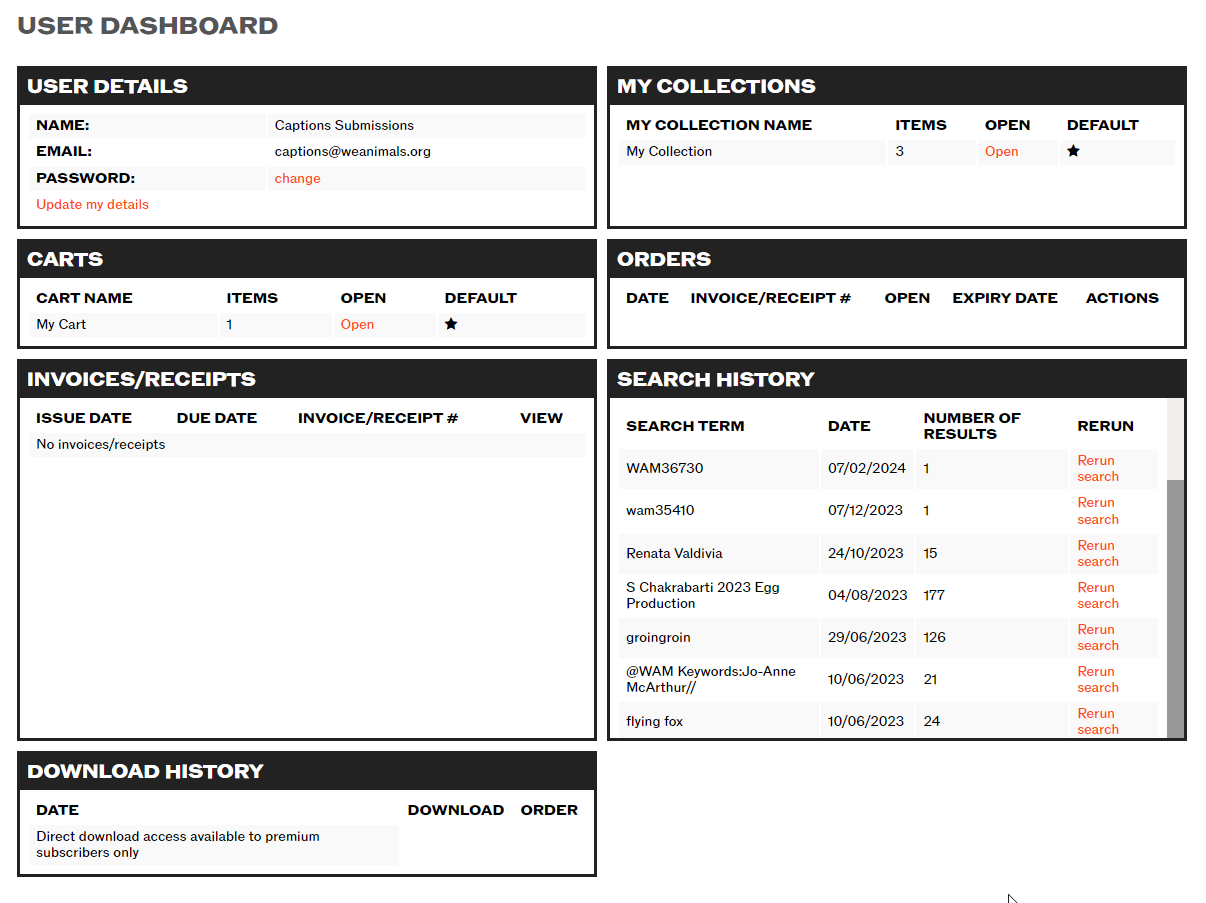
How should I credit We Animals' visuals?
We make our visuals free for non-commercial use to all animal advocates who want to use them for their website, articles, social media, or elsewhere. In return, we ask that you provide the appropriate photographer or videographer accreditation. Learn how to properly credit We Animals’ visuals — and why it’s so important.
Searches
Where do I go to search for visuals?
We’ve made sure that you can search our visuals from multiple places, including via the main navigation of this website.
Within the stock platform environment, you can access the search tool in multiple places. You can use the search bar on the Homepage and on almost any page of the site you can access the search bar in the sub header below our logo. Lastly, you can also find a search bar by clicking ‘Search’ via the menu icon at top right.

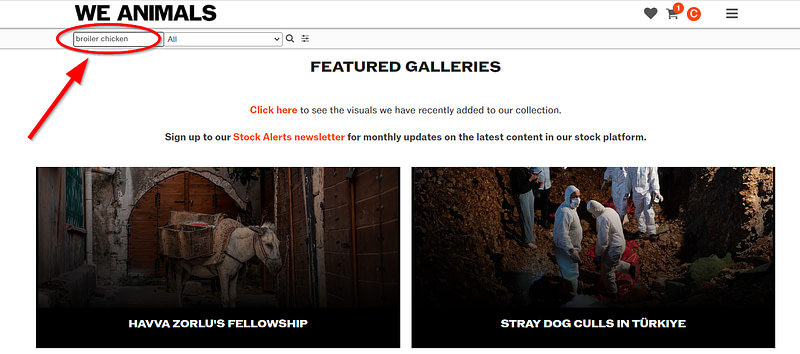
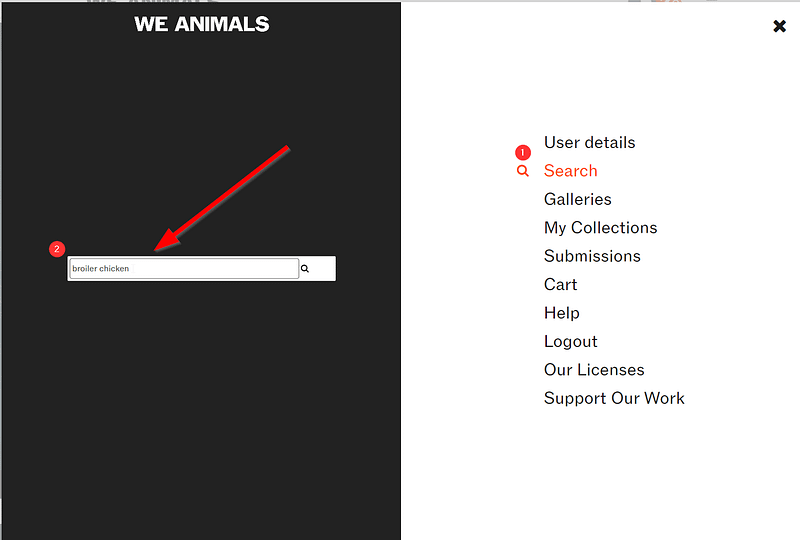

Search results appear as thumbnails in a grid. Scroll down to continue loading more results.
How do I search for only video or only images?
If you’re looking for only video or images, you can narrow your search by that criteria directly within the search bar via a dropdown.
How can I refine my search results?
If you already know the general content of the visuals you’re looking for, try searching within one of our Galleries. Galleries are collections of visuals categorized by topic. You can search within the gallery by entering a search term in the search box in the black pane on the left. This will search only within that gallery.
You can also do a general search and use our advanced filters to find exactly what you’re looking for. Once you enter a search term, a black pane with multiple filter options will appear next to your results.
These filters include:
- Sort Order: Display your results by most relevant, newest first or oldest first.
- Area of Focus: These are the issues we prioritize covering.
- Asset Type: Choose if you want to see images or video or both.
- Category: These are the same categories that you’ll see on our Galleries page.
- Color / Black and White: Most videos will be in color, but you can use this to refine results for images.
- Staff Picks: These are the curated “best of the best” from each shoot
- License Type: Easily ensure that you are only seeing visuals for the type of use you have in mind. You can learn more about our licensing options here.
- Number of Animals: None, 1, 2+ or Animals in background
- Number of People: None, 1, 2+ or People in background
- Orientation: Horizontal, vertical or, square.
- Photographer / Filmmaker: Show visuals produced by a certain photographer / videographer.
- Region: Continents and geographic regions.
Tick the filters you want and click “Filter” to narrow down your results. Re-tick any of the options, then click on “Filter” again to deselect that filter or click on the “Clear Filters” button to deselect all the filters.
Hide the filter bar by using the grey X in the top right corner of the panel. Bring the filters back by clicking on the Search Filters icon beside the search bar.
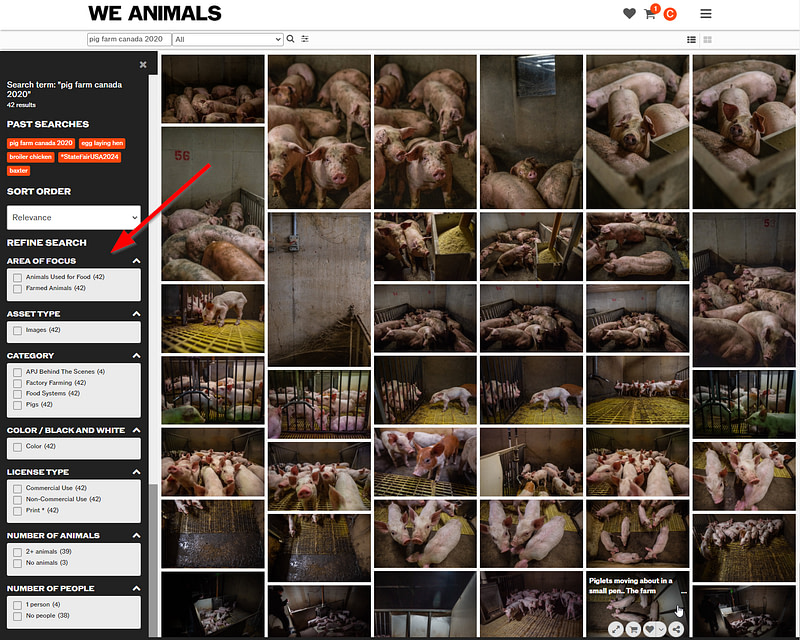
How can I see more information about the visuals in my search results?
Search results are viewable in Thumbnail view or Detail view. (Use the icons under the menu icon at the top right to select your view preference.) In Thumbnail view, when you hover over any of the visuals in the grid, the caption will appear at the top of the visual. In Detail view, that information will appear below each visual along with the filename and the license type(s) that are available.
Click on an image to open it in a preview window. This is where you will find detailed information about that visual, including a brief headline, a long description, the year and location where the visual was shot, the photographer or filmmaker, all the keywords that are associated with the visual and even the scientific name of the species that is featured.
What kind of advanced search options are available?
The advanced search functionality will help you find more specific results by entering simple commands into the search bar. Use these commands in conjunction with our Glossary (next section) to find exactly what you’re looking for.
| Search Modifiers (to be used when entering more than one search term) |
|
| The Phrase Search (“”) |
The phrase search is used to search for exact words or phrases by wrapping the search term in quotation marks (“”). For example, the search command: “fur farming” will return only those visuals that contain the exact phrase fur farming in any of the metadata fields. |
| Strict Order Searching (<<) |
Strict order searching returns visuals where the search terms appear in the order they are entered into the search command. For example, the command: broiler << chick will return only the visuals where broiler comes before chick in the metadata field. It will return broiler chick but not chicks at a broiler farm. |
| Searching Available Metadata Fields |
This is an extremely powerful way to search with direct access to individual metadata fields and multiple search modifiers. Search modifiers and fields can be combined in a single command. The searchable metadata fields are:
Field names and search terms are NOT case sensitive so capital letters can be ignored. This allows for faster entry of search commands. In its simplest form the search command would be: @{metadata field name}:{search term}// So a simple search for sheep in the Headline field would be entered as: @headline:sheep// This would return all visuals with the word sheep in the Headline. It is important to include the forward slash twice (//) at the end to signify the end of the search term for that field. |
| How to Combine Commands |
To build on the simple command above, metadata searches can be combined into a single command with multiple modifiers. So to find all visuals with sheep in the Headline field, and sanctuary in the Sublocation field, you would enter the following search term: @headline:sheep// @sublocation:sanctuary// This would return all visuals with sheep in the Headline field and sanctuary in the Sublocation field, significantly refining the original search. |
Search Term Glossary
With a worldwide user base, we recognize that different people refer to things with different words, depending on where they live. With our new stock collection, we have built a vocabulary of “Preferred Terms” to help you find what you need. Don’t worry, our keywords also include synonyms and common misspellings for each of our preferred terms, so you should still be able to find what you’re looking for. Using our preferred terms will just get you there faster.
See below for a glossary of some of the most common preferred terms that you will see in our collection. Entering these terms into the search bar will yield more accurate results if you are looking for something specific:
| Animal Feeding Operation (AFO) | An agricultural operation where animals are kept and raised in confined situations. An AFO is a lot or facility (other than an aquatic animal production facility) where animals have been, are, or will be confined and fed or maintained for a total of 45 days or more in any 12-month period. |
| Animal Markets | A place where animals or animal parts are sold. Generally open to the public. Pet shops are also considered animal markets. Also see Saleyards & Auctions. |
| Animal Housing/Dwellings: |
|
| Aviculture | The breeding and rearing of birds (wild and domestic). |
| Bovid | An animal belonging to the family ‘bovidae’ (e.g. goats, cattle, antelopes). |
| Bovine | Only refers to cattle, buffalos and bison. |
| Bullock | A young bull. |
| Concentrated Animal Feeding Operation (CAFO) | An AFO (Animal Feeding Operation) with more than 1000 “animal units” (1000 beef cattle, 700 dairy cows, 2500 pigs >55lbs, 125K broiler chickens, 82K layer hens/pullets) confined on site for >45 days. Any size AFO that discharges manure or wastewater into a natural or man-made ditch, stream or other waterway is defined as a CAFO, regardless of size. |
| Cattle | Animal species used in dairy and beef farms, which include both cows (female) and bulls (male). Also see Cow. |
| Companion Animals | Domesticated or domestic-bred animals whose physical, emotional, behavioral and social needs can be readily met as companions in the home, or in close daily relationship with humans. |
| Copy Space | This term indicates that there is a significant amount of free space in the image where copy such as titles could be easily added. For example, images with a significant amount of blue sky or similar uniform background. |
| Cow | A female animal. In particular, bovines, moose, elephants, sea lions, and whales. Also see Cattle. |
| Excrement |
The preferred term for poop. For simplicity, we use this term for poop from any species. |
| Feed |
This is the term we use to describe food that is given to an animal. |
| Investigation |
An “official” undertaking by a recognized organization like the Society for the Prevention of Cruelty to Animals (SPCA) or Humane Society International (HSI), which may result in charges or the seizure of animals. |
| Livestock |
Animals raised in an agricultural setting to produce labor and commodities such as meat, eggs, milk, fur, leather, and wool. |
| Looking in / out / up / down | Describes the activity of the main subject in the visual. |
| Manure |
This term is used to describe fertilizer. |
| Meat |
We only use this term when the animal is dead and is one that is commonly used for food. |
| Overview |
A ‘vista’ / a broad view of the surroundings, such as the interior of a barn. Generally a wide angle shot. Also add Interior or Exterior for more specific search results. |
| Poultry |
All domestic fowl (chickens, turkeys, ducks and geese). |
| Poult |
A young landfowl. This term is restricted to Galliformes; turkey, grouse, chicken and quail. This does not apply to young ducks. |
| Saleyards & Auctions |
Public delivery and collection points to which animals are transported to be sold to the highest bidder and from where animals are then transported to their final destination. Also see Animal Markets. |
| Sanctuary | A permanent home for rescued animals. Also see Shelter. |
| Shelter |
A place where animals live temporarily until they are adopted. Also see Sanctuary. |
| Stereotypic Behavior |
A repetitive, invariant behaviour pattern with no obvious goal or function. This could include pacing, rocking back and forth, turning in circles, chewing on cage bars, etc. |
| Street Animals |
Domesticated animals who do not have a home, but instead live on the streets. |
| Viewpoint: |
|
Collections
Using Collections as a Guest (i.e. You are not logged in)
Add visuals to your collection by clicking the heart icon in the grid view.
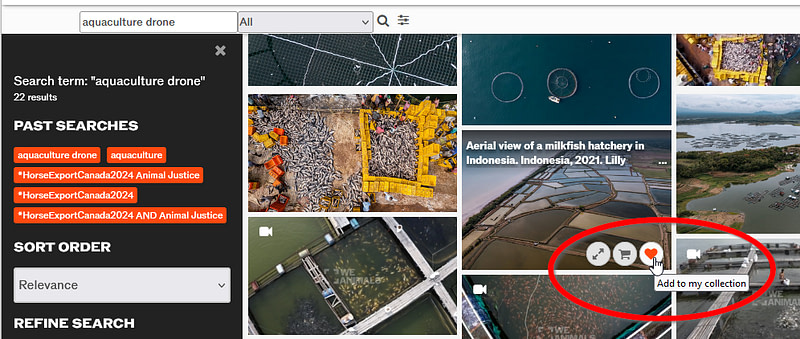
Access your collection via the main menu, or by clicking on the heart icon in the header.
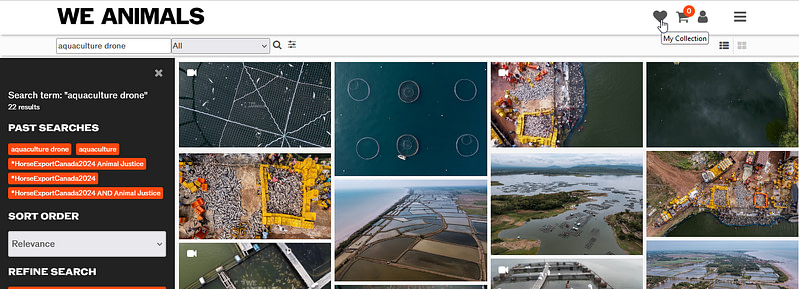
To view the visuals in your collection, click on the menu icon and select “Open panel”. The visuals will appear in a new panel on the left.
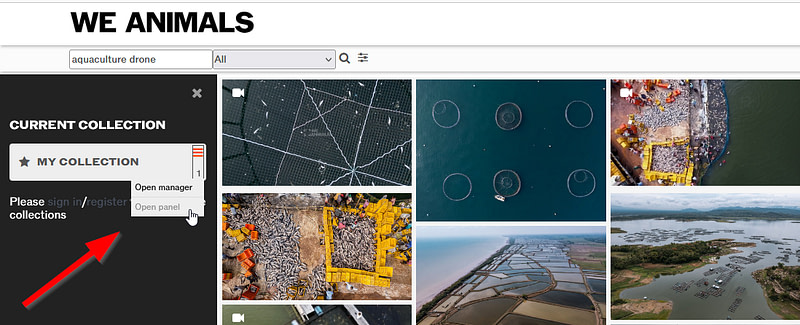
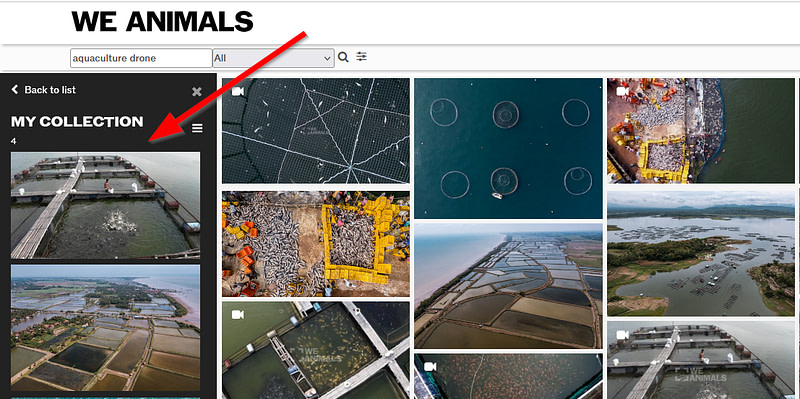
Using the menu icon, select “My Collection Manager” to view the visuals in your collection in a full grid, the way search results are typically displayed.
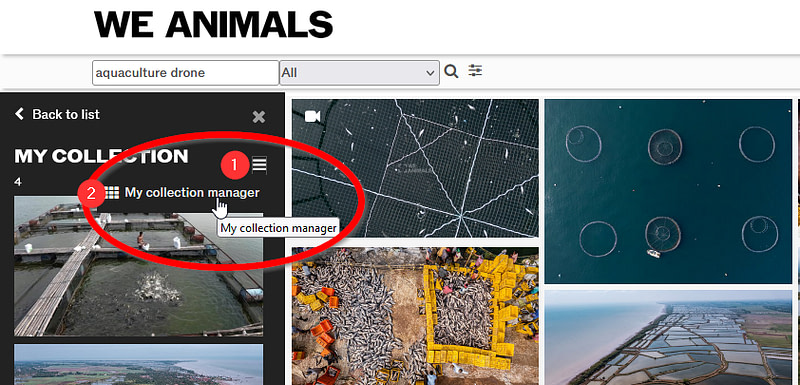

From here, you have the option to add specific visuals or all visuals to your cart. You may either select individual visuals by ticking the white box as shown above, or you may “Select all”. For more information on the cart, see the question “How do I license and download the visuals I want?”
NOTE: As a guest, you will not be able to remove visuals from your collection. You may need to clear your cache and refresh your browser the next time you visit the platform to remove any lingering visuals from your collection.
For additional collection features including creating multiple collections, naming your collections or sharing with others, please refer to the section on Using Collections as a Registered User.
Using Collections as a Registered User (i.e. You are logged in)
Add visuals to your collection by clicking the heart icon in the grid view.

When you want to add more visuals, click on the chevron beside the heart icon and you have the option to add the visual to “My collection”, or to “Create new collection”. You can create as many collections as you want to help you organize your favorite visuals. If you click on the heart icon, the visual will be added to your default collection.

Access your collection(s) via the main menu, or by clicking on the heart icon in the header.

The Collection at the top of the panel is your default collection. To change your default collection, simply click on the star beside one of your saved collections.
Each of the collections you have created will have a menu icon  that provides you with additional options:
that provides you with additional options:
- Open manager – view your collection in a full-screen grid, move or copy visuals from one collection to another, delete specific visuals from your collection or add specific images to your cart
- Open panel – view your collection in the panel
- Notes -see or add notes (these are only visible to you, even if you share the collection)
- Rename – change the name of the collection
- Clone – make a duplicate of the selected collection
- Delete – delete the entire collection
- License – add the entire collection to your cart and navigate to the cart to check out
- Share – get a link to the collection, or share it by email from within our platform
Licenses / Downloads
How do I license and download the visuals I want?
After registering and logging in, you can add items to a cart by clicking on the button with the cart icon.
Multiple carts
You can have more than one cart. This feature is useful if you would like to make multiple orders at different times on different receipts.
To create a new cart, use the “Add new” button on the checkout page. Now you will see multiple cart options on image preview. (Note: if selecting an image from grid view, it will automatically be added to your default cart).
To view the items in a cart, click on its name in the panel. You can also rename or delete a cart from the panel by clicking the hamburger button.
Removing items
To remove any item from the cart, click on the checkbox on the left of the item to select it then click the delete visual button that appears below.
Selecting a license
When in the cart you will be able to select the license you need for your visuals. Under the License Details heading, click ‘Select’ to select your download size and license type. Your price will then be shown on the right ($0 for non-commercial purposes). You can apply your chosen license to either that individual visual, or, if you are using all your selected visuals for the same purpose, you can apply the license to all the visuals in your cart.
Checkout
After you checkout a screen will appear letting you know that your download will begin shortly. If your visuals don’t begin to download automatically, click ‘Download order’ to start the download process.
I’m stuck at the download stage. Why can’t I download my visuals?
This is often the result of using a browser that is not supported. Please try switching to one of the following browsers, which are fully supported:
- Chrome: The latest version and the 2 previously released versions.
- Firefox: The latest version and the 2 previously released versions.
- Edge: The latest version and the 2 previously released versions.
- Internet Explorer: The latest version only.
- Safari: The latest version only.
Delivery method for prints
If you are ordering a print you will need to select a delivery method. Choose the “Standard Shipping” option and enter the address where you want to receive the print. After completing the details, click on the Checkout button to complete your order.
Is there anything I can’t use the visuals for?
Our images cannot be used for any projects that are against animals interests (i.e. projects that promote animal exploitation or suffering). Please read about our licenses here.
I’m being charged tax. Why do you charge taxes?
We Animals is a federally incorporated Canadian not-for-profit organization, with its headquarters in Ontario. We are required to collect and remit sales tax for any sales within Canada, including commercially licensed visuals and/or print orders. Although We Animals is located in Ontario, we are required to charge the tax rate that applies in the province in which the purchaser is located. If you are located outside of Canada no taxes will be charged.
We Animals collect sales tax for Canadian transactions (GST/HST/PST) as follows:
| RATE | |||
| Province | GST/HST | PST | Total |
| Alberta | 5% GST | — | 5% |
| British Columbia | 5% GST | — | 5% |
| Manitoba | 5% GST | — | 5% |
| New Brunswick | 15% HST | — | 15% |
| Newfoundland & Labrador | 15% HST | — | 15% |
| Nova Scotia | 15% HST | — | 15% |
| Northwest Territories | 5% GST | — | 5% |
| Nunavut | 5% GST | — | 5% |
| Ontario | 13% HST | — | 13% |
| Prince Edward Island | 15% HST | — | 15% |
| Quebec | 5% GST | — | 5% |
| Saskatchewan | 5% GST | 6% PST | 11% |
| Yukon | 5% GST | — | 5% |
Refund and Exchange Policies
Licensing of Visual Content
Commercial Use and Restricted Commercial Use Licenses (Stock site): There are no refunds or exchanges of any kind for Work(s) once downloaded.
Subscription Licenses (Stock site): The subscription license fee is non-refundable.
Books
Donations
Please visit our Donation Refund Policy.
